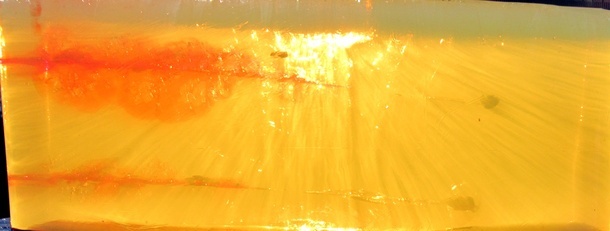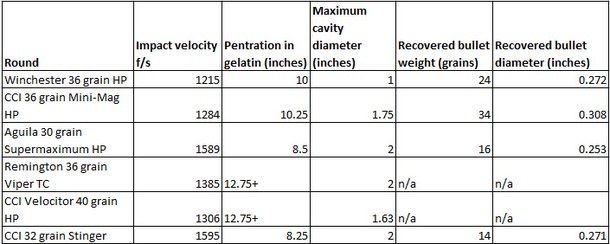In part one of my investigation into the terminal performance potential of the .22 LR, I tested and examined a variety of subsonic loads for the world’s favorite rimfire round. Among the more interesting results yielded from that round of tests were those of the Aguila 60 grain Sniper Subsonic round. The bullet, which was far too long and heavy to be stabilized by 1:16 rifling twist typical of most .22 LR rifles, apparently rotated end over end during its trip through the gel block creating a cavity far wider than those carved by most .22 LR loads.
The second part of the investigation focused on much speedier .22 LR loads. Velocities of the tested rounds ranged from a fairly middle of the road 1,215 f/s to speeds just shy of 1,600 f/s. All shots were fired from a Savage Mark IV with a 16-inch barrel into blocks of 10 percent gelatin from a range of ten feet. Results are detailed below.
Winchester 36-grain hollow point
This fairly typical, inexpensive, round for the .22 LR impacted the gel block at a velocity of 1,215 f/s. the hollow tip of the bullet fragmented into tiny lead shards while the stem of the projectile penetrated to a depth of 10-inches. Maximum cavity width was approximately 1-inch and the primary bullet fragment was .272” in diameter with a retained mass of 24-grains. Being cheap and abundant, these basic Winchester hollow points are more than up to the task of pest control and are perfect for vaporizing fun plinking targets such as old fruit and vegetables.
CCI 36-grain Mini-Mag hollow point
In spite of being in the same standard weight and velocity class as the Winchester hollow point, the CCI Mini-Mag yielded noticeably improved performance over its sister round. Such a performance increase is, however, reflected in the higher price of the Mini-Mags.
The bullet impacted the block at a velocity of 1,284 f/s, penetrated to a depth of 10-1/4-inches, and opened a cavity that had a maximum width of 1-3/4 inches. Unlike the Winchester bullet, the Mini-Mag bullet did not fragment but opened up to a diameter of .308” and retained 34-grains of mass.
Aguila 30-grain Supermaximum hollow point
In spite of an advertised velocity of 1,700 f/s, the Aguila Supermaximum only reached 1,589 f/s from my savage, putting it on par –in terms of velocity – with the CCI Stinger round. To be fair, I only had time to fire and chronograph a single round from the box of 50 and the low velocity figure may have been an isolated issue.
Still, the performance of the Supermaximum in the gel block was hardly unspectacular. The light, fast, hollow point bullet fragmented explosively upon impact with the smaller bullet shards penetrating to a depth of about 6-1/4 inches. The stem of the bullet came to a rest after traversing 8-1/2 inches of gel. The maximum cavity width was two-inches and the bullet stem was .253” in diameter with a mass of 16-grains.
Remington 36-grain Viper truncated cone
In many respects, the Remington Viper outperformed all of the other .22 LR tested during the session. The 36-grain bullet impacted the block at a velocity of 1,385 f/s and completely penetrated the 12-3/4 inch length of the block. The maximum width of the cavity it tore in the gel was two-inches. Unfortunately, the bullet stopped when it collided with the wax backer block placed after the gel, rolled off the test stand, and was never found. I was thus unable to analyze a recovered bullet.
The Viper was the only .22 LR round I tested that penetrated the entirety of the gel block and also carved a two-inch wide cavity. It is clearly one of the more potent .22 loads available.

Above: The path the Remington Viper took through the gel block. The entry point is at the right of the frame.
CCI 40-grain Velocitor hollow point
The CCI Velocitor ran a very close second to the Remington Viper in terms of both penetration and cavitation in the gel block. After impacting a velocity of 1,306 f/s, the bullet cleared the entire 12-3/4 inches of gelatin after tearing a 1-5/8 inch cavity. In a manner similar to the Viper, the Velocitor rolled off the test stand, never to be found. It certainly would have been nice to have been able to examine the condition of the recovered bullet, but the damage done to the gelatin is evidence enough that it held together and did its job.
CCI 32-grain Stinger hollow point
The CCI Stinger is probably the best-known of all the available hyper-velocity 22 LR hollow point rounds and has a well-deserved reputation as a highly effective varmint load. In all honesty, testing the Stinger was an exercise in redundancy, but I had the gelatin and I had the rounds, so why not have a little fun?
The bullet hit the block at a velocity of 1,595 f/s and, as expected, violently fragmented into small pieces shortly after impact. The resulting cavity in the gel was a shade over two-inches in width and the largest fragment (bullet stem) penetrated to a depth of 8-1/4 inches. The largest recovered bullet fragment was .271” in diameter and weighed only 14-grains.

Above: The channels carved through the gel block by the CCI Velocitor (top) and the CCI Stinger (bottom).

Above: Recovered bullets from left to right; the Winchester hollow point, CCI Mini-Mag, Aguila Super Maximum, and the CCI Stinger.
If these informal terminal performance tests demonstrate nothing else, it is the wide range of applications for which the .22 LR is capable. With the proper ammo and a competent operator, the .22 can take small game without destroying an inordinate amount of meat, quickly and humanely dispatch destructive vermin, or in the gravest, most desperate of circumstances, take large game animals and defend life and limb.
Related Article: The venerable .22 LR vs. gelatin part I: subsonic rounds (3469)








